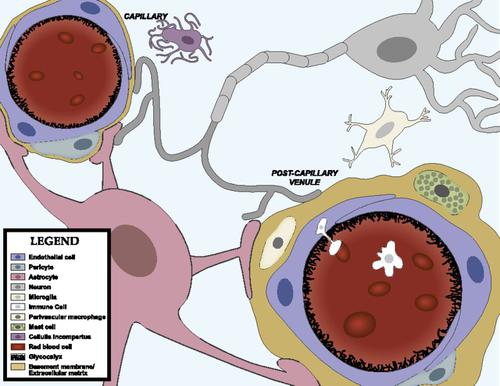当前位置:
X-MOL 学术
›
Pharmacol. Rev.
›
论文详情
Our official English website, www.x-mol.net, welcomes your
feedback! (Note: you will need to create a separate account there.)
Neuroimmune Axes of the Blood–Brain Barriers and Blood–Brain Interfaces: Bases for Physiological Regulation, Disease States, and Pharmacological Interventions
Pharmacological Reviews ( IF 19.3 ) Pub Date : 2018-04-01 , DOI: 10.1124/pr.117.014647 Michelle A Erickson 1 , William A Banks 2
Pharmacological Reviews ( IF 19.3 ) Pub Date : 2018-04-01 , DOI: 10.1124/pr.117.014647 Michelle A Erickson 1 , William A Banks 2
Affiliation

|
Central nervous system (CNS) barriers predominantly mediate the immune-privileged status of the brain, and are also important regulators of neuroimmune communication. It is increasingly appreciated that communication between the brain and immune system contributes to physiologic processes, adaptive responses, and disease states. In this review, we discuss the highly specialized features of brain barriers that regulate neuroimmune communication in health and disease. In section I, we discuss the concept of immune privilege, provide working definitions of brain barriers, and outline the historical work that contributed to the understanding of CNS barrier functions. In section II, we discuss the unique anatomic, cellular, and molecular characteristics of the vascular blood–brain barrier (BBB), blood–cerebrospinal fluid barrier, and tanycytic barriers that confer their functions as neuroimmune interfaces. In section III, we consider BBB-mediated neuroimmune functions and interactions categorized as five neuroimmune axes: disruption, responses to immune stimuli, uptake and transport of immunoactive substances, immune cell trafficking, and secretions of immunoactive substances. In section IV, we discuss neuroimmune functions of CNS barriers in physiologic and disease states, as well as pharmacological interventions for CNS diseases. Throughout this review, we highlight many recent advances that have contributed to the modern understanding of CNS barriers and their interface functions.
中文翻译:

血脑屏障和血脑界面的神经免疫轴:生理调节、疾病状态和药理干预的基础
中枢神经系统(CNS)屏障主要介导大脑的免疫特权状态,也是神经免疫通讯的重要调节器。人们越来越认识到大脑和免疫系统之间的通信有助于生理过程、适应性反应和疾病状态。在这篇综述中,我们讨论了调节健康和疾病中神经免疫通讯的脑屏障的高度专业化特征。在第一节中,我们讨论免疫特权的概念,提供脑屏障的工作定义,并概述有助于理解中枢神经系统屏障功能的历史工作。在第二节中,我们讨论血管血脑屏障(BBB)、血脑脊液屏障和长细胞屏障的独特的解剖学、细胞和分子特征,这些特征赋予它们作为神经免疫界面的功能。在第三节中,我们将血脑屏障介导的神经免疫功能和相互作用分为五个神经免疫轴:破坏、对免疫刺激的反应、免疫活性物质的摄取和运输、免疫细胞运输和免疫活性物质的分泌。在第四节中,我们讨论中枢神经系统屏障在生理和疾病状态下的神经免疫功能,以及中枢神经系统疾病的药物干预。在这篇综述中,我们重点介绍了许多有助于现代理解中枢神经系统屏障及其界面功能的最新进展。
更新日期:2018-06-03
中文翻译:

血脑屏障和血脑界面的神经免疫轴:生理调节、疾病状态和药理干预的基础
中枢神经系统(CNS)屏障主要介导大脑的免疫特权状态,也是神经免疫通讯的重要调节器。人们越来越认识到大脑和免疫系统之间的通信有助于生理过程、适应性反应和疾病状态。在这篇综述中,我们讨论了调节健康和疾病中神经免疫通讯的脑屏障的高度专业化特征。在第一节中,我们讨论免疫特权的概念,提供脑屏障的工作定义,并概述有助于理解中枢神经系统屏障功能的历史工作。在第二节中,我们讨论血管血脑屏障(BBB)、血脑脊液屏障和长细胞屏障的独特的解剖学、细胞和分子特征,这些特征赋予它们作为神经免疫界面的功能。在第三节中,我们将血脑屏障介导的神经免疫功能和相互作用分为五个神经免疫轴:破坏、对免疫刺激的反应、免疫活性物质的摄取和运输、免疫细胞运输和免疫活性物质的分泌。在第四节中,我们讨论中枢神经系统屏障在生理和疾病状态下的神经免疫功能,以及中枢神经系统疾病的药物干预。在这篇综述中,我们重点介绍了许多有助于现代理解中枢神经系统屏障及其界面功能的最新进展。











































 京公网安备 11010802027423号
京公网安备 11010802027423号